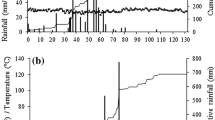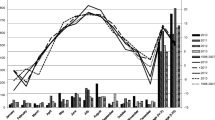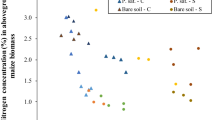Abstract
Effects of application of prunings of three woody species (Acioa barteri, Gliricidia sepium and Leucaena leucocephala), maize (Zea mays L.) stover and rice (Oryza sativa L.) straw as mulch on maize were studied on an Alfisol in southern Nigeria in 1990 and 1991. Maize dry matter and grain yield were higher with applications of plant residues and N fertilizer in both years. Addition of Leucaena prunings gave the highest maize grain yield in both years. Compared to the 1990 results, Acioa showed the least grain yield decline among the mulch treatments in 1991. Nutrient uptake was enhanced by applications of plant residues. Leucaena prunings had the highest effect in both years and increased the mean N, P, and Mg uptake by 96%, 84%, and 50%, respectively, over the control. Addition of Acioa prunings increased K and Ca uptake by 59% and 92%, respectively, over the control. ‘High quality’ (low C/N ratio and lignin level) plant residues enhance crop performance through direct nutritional contributions, whereas ‘low quality’ (high C/N ratio and lignin level) plant residues do so through mulching effects on the microclimate. ‘Intermediate quality’ plant residues have no clear effects on crop performance.
Similar content being viewed by others
References
Allmaras R R and Nelson W W 1971 Corn (Zea mays L.) root configuration as influenced by row-interrow variants of tillage and straw mulch management. Soil Sci. Soc. Am. Proc. 35, 974–980.
Balasubramanian V and Nnadi L A 1980 Crop residue management and soil productivity in Savanna areas of Nigeria. FAO Soil Bull. 43, 106–120.
Chaudhary M R and Prihar S S 1974 Root development and growth response of corn following mulching, cultivation, or interrow compaction. Agron. J. 66, 350–355.
Fox R H, Myers R J K and Vallis I 1990 The nitrogen mineralization rate of legume residues in soil as influenced by their polyphenol, lignin, and nitrogen contents. Plant and Soil 129, 251–259.
Hillel D 1971 Soil and Water Physical Principles and Processes. Academic Press, New York/London.
Hulugalle N, Lal R and Ter Kuile C H H 1986 Amelioration of soil physical properties by Mucuna after mechanized land clearing of a tropical rain forest. Soil Sci. 141, 219–224.
IITA (International Institute of Tropical Agriculture) 1981 Automated and semi-automated methods for soil and plant analysis. Manual series No. 7. IITA, Ibadan, Nigeria.
Jones M J 1976 Effect of three N fertilizers and lime on pH and exchangeable cation content at different depth in cropped soils at two sites in the Nigerian Savanna. Trop. Agric. 53, 243–254.
Kang B T and Spain K M 1986 Management of low activity clays with special references to Alfisols, Ultisols and Oxisols in the tropics. In Proc. Symp. on Low Activity Clay (LAC) Soils. pp 107–131 SMSS, Washington, DC.
Kang B T and Wilson G F 1987 The development of alley cropping as a promising agroforestry technology. In Agroforestry, a Decade of Development. Eds. H ASteppler and P K RNair. pp 227–243. ICRAF, Nairobi, Kenya.
Kang B T, Sipkens L, Wilson G F and Nangju D 1981 Leucaena (Leucaena leucocephala (Lam) de wit) prunings as nitrogen source for maize (Zea mays L.). Fert. Res. 2, 279–287.
Lal R 1978 Influence of with- and between-row mulching on soil temperature, soil moisture, root development and yield of maize (Zea mays L.) in a tropical soil. Field Crop Res. 1, 127–139.
Maurya P R and Lal R 1981 Effect of different mulch materials on soil properties and the root growth and yield of maize (Zea mays) and cowpea (Vigna unguiculata). Field Crop Res. 4, 33–45.
Palm C A and Sanchez P A 1991 Nitrogen release from the leaves of some tropical legumes as affected by their lignin and polyphenolic content. Soil Biol. Biochem. 23, 83–88.
Russell R S 1977 Plant Root Systems: Their Function and Interaction with the Soil. McGraw-Hill, London.
Sanchez P A and Salinas J G 1981 Low input technology for managing Oxisols and Ultisols in tropical America. Adv. Agron. 34, 279–306.
Swarup A 1987 Effect of presubmergence and green manuring (Sesbania aculeata) on nutrition and yield of wetland rice (Oryza sativa L.) on a sodic soil. Biol. Fertil. Soils 5, 203–208.
Tian G, Kang B T and Brussaard L 1992 Biological effect of plant residues with contrasting chemical composition under humid tropical conditions-Decomposition and nutrient release. Soil Biol. Biochem. 24, 1051–1060.
Wade W K and Sanchez P A 1983 Mulching and green manure application for continuous crop production in the Amazon basin. Agron J. 75, 39–45.
Yamoah C H, Agboola A A and Mulongoy K 1986 Decomposition, nitrogen release and weed control by prunlings of selected alley cropping shrubs. Agrof. Syst. 4, 234–246.
Author information
Authors and Affiliations
Rights and permissions
About this article
Cite this article
Tian, G., Kang, B.T. & Brussaard, L. Mulching effect of plant residues with chemically contrasting compositions on maize growth and nutrients accumulation. Plant Soil 153, 179–187 (1993). https://doi.org/10.1007/BF00012990
Received:
Accepted:
Issue Date:
DOI: https://doi.org/10.1007/BF00012990




